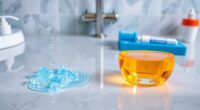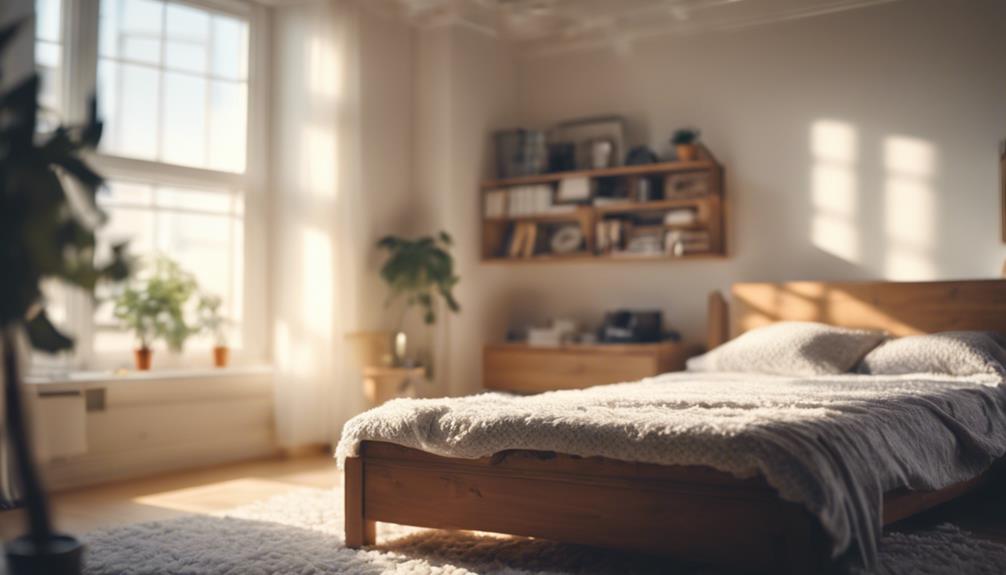To maintain your tile floor without commercial cleaners, start by sweeping or vacuuming regularly to remove dirt. Use a vinegar and water mixture for routine mopping, but avoid it on natural stone tiles. For tough stains, make a baking soda paste and scrub gently. Keep grout clean by using a baking soda and water solution. Don't forget to place mats at entryways to trap dirt. There's so much more you can learn about caring for your tiles effectively.
Key Takeaways
- Regularly sweep or vacuum to remove dirt and grit, preventing buildup and scratches on tile surfaces.
- Use a vinegar and water mixture for general cleaning, avoiding it on natural stone tiles to prevent damage.
- Create a baking soda paste for tough stains and scrub gently with a soft brush for effective stain removal.
- Place mats at entryways to reduce dirt tracked onto floors, maintaining cleanliness and appearance.
- Establish a routine cleaning schedule to ensure consistent maintenance and prevent long-term damage or discoloration.
The Importance of Regular Maintenance

While you may appreciate the beauty of your tile floor, keeping it well-maintained is essential for its longevity and appearance. Regular maintenance helps prevent dirt and grime buildup, which can lead to discoloration and damage over time.
By consistently cleaning tile floors, you reduce the risk of slips and falls, ensuring a safer environment for you and your family. Don't forget to inspect grout lines regularly; catching issues early can save you from costly repairs.
A clean tile floor also promotes a healthier indoor environment, minimizing allergens and pollutants that affect air quality. Establishing a routine cleaning schedule allows you to extend your flooring's lifespan, protecting your investment and keeping it looking great for years to come. Additionally, using different materials for your cleaning tools can enhance the effectiveness of your maintenance routine.
Natural Cleaning Solutions for Tile Floors

When it comes to cleaning your tile floors, natural solutions can be both effective and safe.
A simple mixture of vinegar and water works wonders, while baking soda can tackle stubborn stains with ease.
To enhance your cleaning routine, consider adding essential oils for a fresh scent and added antibacterial properties. Additionally, maintaining a high vibrational energy while cleaning can enhance your overall well-being and mindfulness.
Vinegar and Water Solution
A simple vinegar and water solution can be your go-to for cleaning tile floors effectively and naturally.
Mix one cup of vinegar with one gallon of warm water to create an efficient cleaning solution. This natural option removes dirt and grime while acting as a mild disinfectant, perfect for kitchens and bathrooms.
When mopping unsealed ceramic tile, be careful not to soak the surface too much to avoid damage. After mopping with the vinegar solution, rinse the floor with clean water to eliminate any residue, preventing dullness from buildup.
Regular use of this vinegar and water solution helps maintain the shine of your tiles and keeps grout lines looking fresh. Additionally, incorporating natural cleaning solutions into your routine can minimize the need for harsh chemicals.
Just remember to avoid it on natural stone tiles!
Baking Soda Paste
Create a powerful cleaning solution by mixing baking soda with water to form a paste, perfect for tackling tough stains on tile floors. Combine three parts baking soda with one part water for a thick consistency. Apply the paste to stained areas and let it sit for 10 to 15 minutes. Then, use a soft-bristle brush to gently scrub the paste into the tiles and grout lines. Regular maintenance of your floor can help maintain efficiency in keeping your home clean.
| Step | Action |
|---|---|
| 1 | Mix baking soda and water |
| 2 | Apply paste to stains |
| 3 | Let it sit for 10-15 minutes |
| 4 | Scrub with a soft bristle brush |
| 5 | Rinse with warm water & dry |
Finish by rinsing the area to remove residue. Enjoy your clean floors!
Essential Oil Boosters
Adding essential oils to your cleaning routine can elevate your tile floor maintenance. Oils like tea tree and lavender not only provide pleasant scents but also offer antibacterial properties in your homemade cleaning solutions.
For tough spots, mix lemon essential oil with warm water and vinegar; it acts as a natural degreaser and stain remover. Peppermint oil gives a revitalizing aroma while boosting the antimicrobial strength of your cleaner.
Don't forget eucalyptus essential oil; just a few drops in your mop solution can help disinfect and freshen surfaces. Using essential oils alongside air purifiers can further enhance the cleanliness of your living space by reducing airborne pollutants.
Remember to dilute these essential oils in water or vinegar to protect your grout and tile finishes while enhancing your cleaning effectiveness.
Enjoy your naturally clean and inviting floors!
Effective Techniques for Cleaning Grout

Cleaning grout doesn't have to be a hassle. You can whip up a simple DIY grout cleaner using baking soda and water, and with regular maintenance, your grout can stay looking fresh. Additionally, incorporating regular filter replacement into your cleaning routine can improve overall air quality, which may help reduce the accumulation of dust and debris in your home.
Let's explore some effective techniques to keep those grout lines sparkling clean.
DIY Grout Cleaner Recipe
For a quick and effective solution to grout stains, you can whip up a simple DIY grout cleaner using just two ingredients: baking soda and water. Mix equal parts of baking soda and water to create a thick paste. For tougher stains, add a few tablespoons of hydrogen peroxide to boost its cleaning power. Apply the paste directly to the grout lines and let it sit for 10 to 15 minutes. Then, scrub with a toothbrush or grout brush for the best results. Regular cleaning can help maintain the appearance of your tile floor and prevent vampire power from appliances that may be used in the kitchen.
| Step | Action | Notes |
|---|---|---|
| 1 | Mix baking soda and water | Form a thick paste |
| 2 | Apply to grout | Cover all stained areas |
| 3 | Scrub with a brush | Use a toothbrush or grout brush |
| 4 | Rinse off the cleaner | Use warm water to rinse |
This will effectively clean your tile!
Regular Grout Maintenance Tips
While maintaining your tile floor, regular grout upkeep is essential to prevent stains and discoloration.
Start by regularly inspecting your grout lines for any discoloration or damage. Clean them every few months using effective cleaning techniques, like creating a baking soda and water paste. Apply it directly to the stained areas, scrubbing gently with a toothbrush or grout brush.
For stubborn grout stains, a diluted bleach-water solution can help; just let it sit for a few minutes before rinsing. Don't forget to seal grout lines every 1-2 years to protect against moisture and staining.
Finally, a pencil eraser can work wonders for small stains, restoring the original color without harsh chemicals. Regular cleaning of grout helps maintain clean fuel injectors and enhances overall cleanliness in your home.
Tips for Preventing Dirt Accumulation

Maintaining a clean tile floor doesn't have to be a chore; just a few simple steps can greatly reduce dirt accumulation.
Start by regularly sweeping or vacuuming your floor at least once a week. This helps remove dirt, sand, and grit that can scratch your tiles.
Next, place mats at entry points to trap dirt and moisture, keeping the debris from spreading throughout your home. Adopting a no-shoes policy in certain areas can also minimize outdoor grime.
Additionally, use protective pads under furniture legs to prevent scratches and reduce dust accumulation in corners.
Finally, don't forget to schedule periodic deep cleaning sessions to tackle built-up grime and keep your tile floors looking fresh and vibrant. Regular cleaning methods are essential for improving efficiency and ensuring your floors maintain their appearance over time.
Specific Care for Different Tile Types
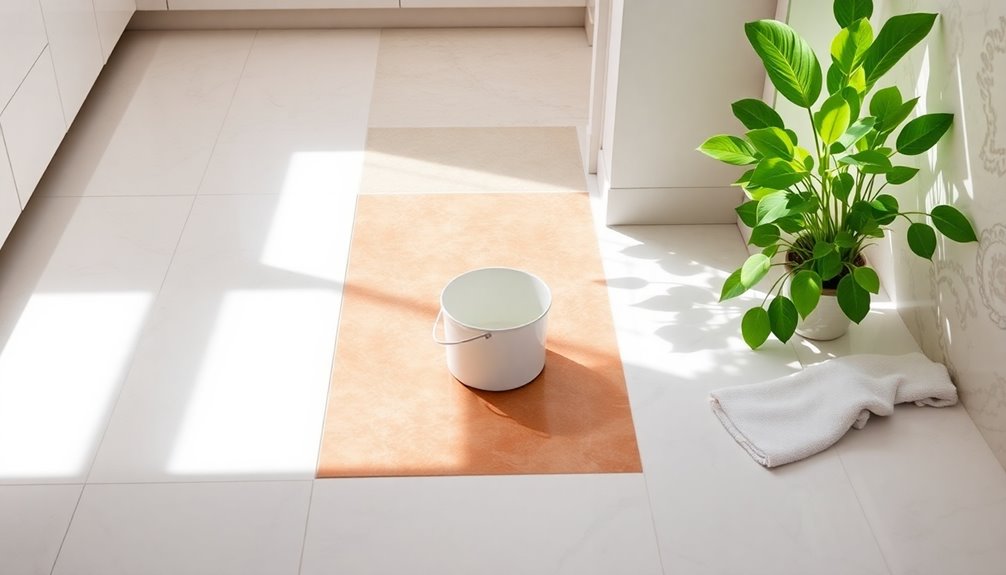
Different tile types require tailored care to keep them looking their best.
For ceramic tile floors, make sure to sweep or vacuum regularly, then mop with warm water and mild dish soap.
Natural stone tiles, like granite and marble, need pH-neutral cleaners to prevent etching.
If you have slate tiles, use warm water and mild detergent, avoiding acidic solutions.
For unglazed tiles, a vinegar and warm water mixture with a soft bristle brush works well, but remember to rinse thoroughly.
Keep your tile grout in shape by creating a baking soda paste for gentle scrubbing, which restores its color without harsh commercial cleaners. Regular preventive maintenance can also enhance the longevity of your tile floors.
Following these tips will help maintain the beauty of your tiles.
How to Deal With Tough Stains
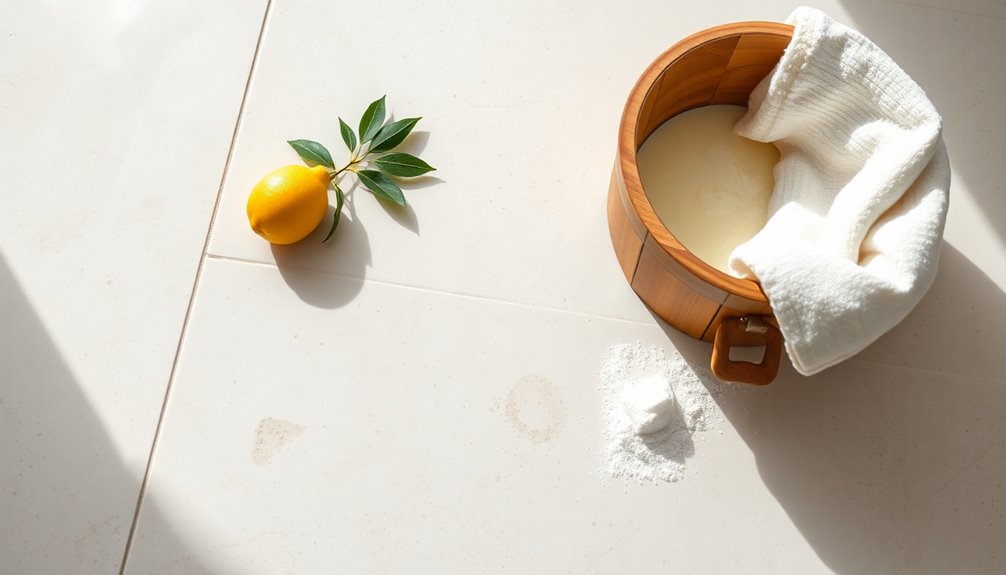
Tough stains can be a real headache, but dealing with them effectively keeps your tile floor looking pristine.
For ceramic and porcelain tiles, mix baking soda and water to form a paste, apply it to the stain, and let it sit for 10-15 minutes before gently scrubbing with a soft-bristle brush.
For grease stains, use a cleaning method of warm water and mild detergent to break down the oils—apply, scrub, and rinse.
Grout stains benefit from a bleach-water solution, mixed at one part bleach to four parts water.
For hard water stains, a 50/50 vinegar and water solution works wonders.
Finally, for natural stone, opt for a pH-neutral cleaner to avoid damage.
The Benefits of Using Mats and Rugs

Using mats and rugs at entry points is a smart way to keep dirt and debris from getting tracked onto your tile floors.
Not only do they help maintain cleanliness, but they also add aesthetic appeal to your space.
Dirt Prevention Strategies
While it might seem minor, placing mats and rugs at entry points can make a significant difference in keeping your tile floors clean.
Studies show that up to 80% of dirt in indoor spaces comes from shoes, so effective dirt prevention strategies are essential. Using area rugs in high-traffic zones provides an additional barrier against grime, protecting your tile surfaces.
Mats with rubber backing prevent slipping, ensuring they capture dirt without becoming a tripping hazard. Regularly vacuuming or shaking out these mats helps maintain their effectiveness in trapping dirt, reducing the need for deep cleaning.
During wet weather, absorbent mats can prevent water pooling, minimizing slip risks and protecting grout lines, making your floors last longer.
Enhanced Aesthetic Appeal
Mats and rugs not only help keep your tile floors clean but also enhance their aesthetic appeal. By placing mats at entry points, you reduce dirt and debris from entering your home, which minimizes how often you need to clean your floors.
Textured mats can trap moisture, preventing slips and enhancing safety, especially in wet areas. Strategically positioned area rugs can define spaces in open floor plans, adding warmth and inviting comfort to your tile surfaces.
Regularly cleaned mats and rugs improve indoor air quality by trapping allergens and dust. Investing in washable rugs makes it easy to maintain that high aesthetic appeal without resorting to harsh commercial cleaners, keeping your home looking great effortlessly.
Routine Care for Long-lasting Shine

To keep your tile floor looking its best, it's essential to establish a routine care schedule.
Start by sweeping or vacuuming at least once a week to remove dirt and grit that can scratch your tiles.
Mop your floors biweekly with a solution of warm water and mild detergent to maintain their shine and remove surface residue.
Every few months, use a soft-bristle brush to gently scrub grout lines with a paste of baking soda and water, keeping them bright.
After mopping, dry your tiles immediately with a lint-free cloth to prevent water spots.
Finally, place mats at entryways to catch dirt and debris, minimizing what gets tracked onto your tile floors.
Common Mistakes to Avoid
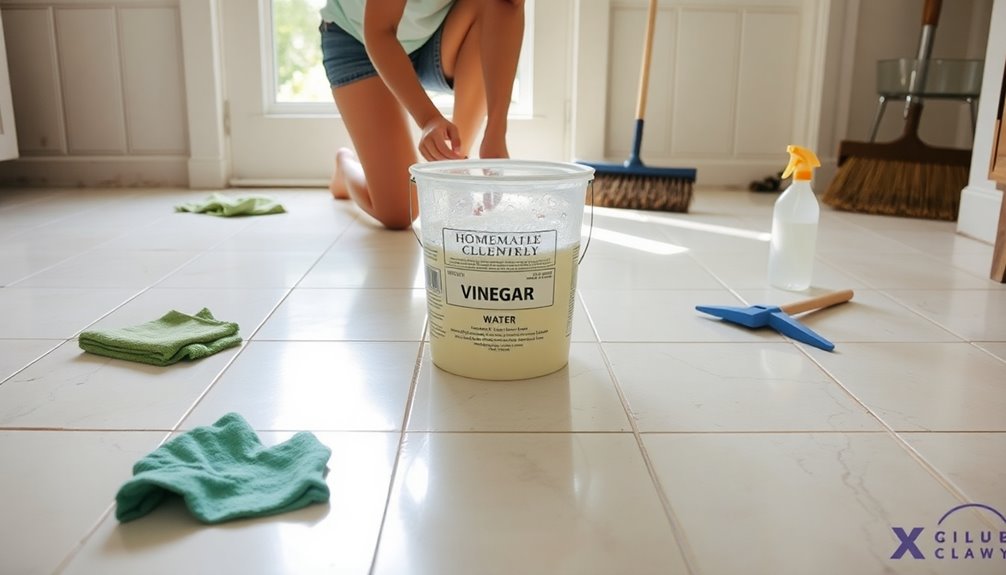
When caring for your tile floor, it's easy to make mistakes that can lead to damage or dullness. To keep your floors in top shape, avoid cleaning with dirty water, as it leaves residue. Don't use vinegar or harsh cleaning products that contain acids on natural stone, which can etch surfaces. Stick to mild detergents instead. Avoid abrasive scrubbers on glazed tiles, as they can scratch finishes. Always clean spills promptly to prevent stains, especially on porous grout.
| Mistake | Consequence | Solution |
|---|---|---|
| Using dirty water | Residue and streaks | Change mop water regularly |
| Using acidic cleaners | Etching and damage | Use pH-neutral cleaners |
| Letting spills sit | Permanent stains on grout | Clean spills immediately |
Eco-Friendly Alternatives to Commercial Cleaners
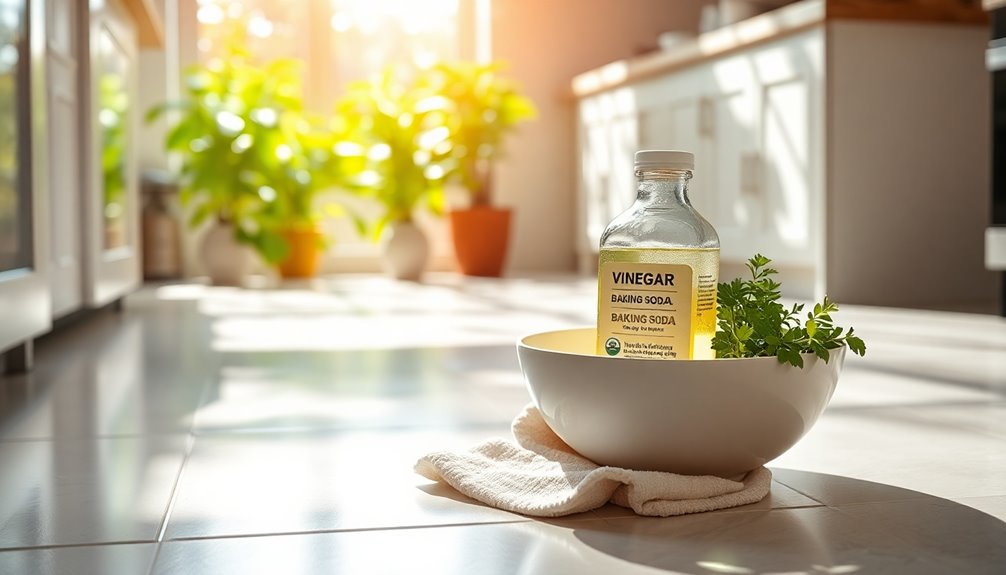
Maintaining a clean tile floor doesn't have to rely on commercial cleaners filled with harsh chemicals. Instead, you can use eco-friendly alternatives that are effective and safe.
Start with a mixture of vinegar and water in a 1:1 ratio to dissolve dirt, but avoid using it on natural stone tiles. For tough stains, create a paste with baking soda and water to gently scrub grout without damaging the tiles.
You can also dilute Castile soap in warm water for a biodegradable solution. Enhance your cleaners with a few drops of essential oils, like tea tree or lavender, for antibacterial properties and a pleasant scent.
Finally, use hydrogen peroxide directly on stains, letting it sit for 10-15 minutes before rinsing.
Frequently Asked Questions
How Do You Deep Clean Tile Floors Without Scrubbing?
To deep clean tile floors without scrubbing, grab a steam mop to sanitize and lift dirt effortlessly.
Alternatively, mix vinegar with warm water, let it sit for 5 to 10 minutes, and then rinse to tackle stubborn stains.
You can also sprinkle baking soda before mopping for a foaming action that loosens grime.
For grout, apply a baking soda paste, let it sit, and rinse for a thorough clean without scrubbing.
What Is a Good Alternative to Tile Floor Cleaner?
A good alternative to tile floor cleaner is a simple mixture of warm water and a few drops of mild dish soap. This gentle solution effectively removes dirt without harsh chemicals.
You can also try a vinegar and water mix for unglazed tiles, which helps break down grease.
For stubborn stains, create a paste with baking soda and water.
These natural options keep your floors clean and safe for your family and pets.
What Is the Best Thing to Clean Tile Floors With?
The best thing to clean tile floors with is a simple mixture of warm water and mild dish soap. This combination effectively removes dirt without harming your tiles or grout.
For unglazed tiles, try a vinegar and warm water solution—just let it sit for 5 to 10 minutes before rinsing.
Always use a soft-bristle brush or cloth mop to protect the surface, and don't forget to change your cleaning water regularly for ideal results.
Is It Worth It to Have Tile Professionally Cleaned?
Yes, it's worth it to have tile professionally cleaned.
Professionals can restore your tiles and grout to their original shine, especially in high-traffic areas where dirt accumulates. They use advanced equipment and techniques that can tackle deep stains more effectively than standard cleaning methods.
Conclusion
By embracing natural cleaning solutions, adopting effective techniques, and preventing dirt accumulation, you're not just maintaining your tile floor; you're enhancing its beauty, extending its life, and protecting your health. With specific care for each tile type and the strategic use of mats and rugs, you create a cleaner, safer space. Avoid common mistakes, and choose eco-friendly alternatives to commercial cleaners. In doing so, you'll enjoy a sparkling clean home while caring for the planet.


